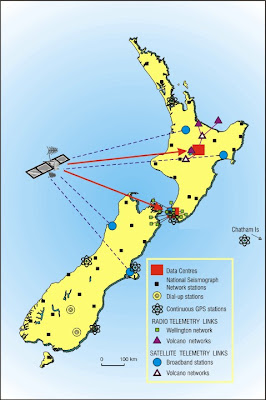One of the obvious questions to ask about the launch of GeoNet Rapid (Beta) is - why now? Why didn’t we have it before the Canterbury
earthquakes began? There are three factors to consider when answering these
questions: the coverage of the GeoNet sensor networks, the rapid development of
the systems and technology used to locate earthquakes and the long thin and
plate boundary nature of New Zealand. GeoNet Rapid is the “tip of the iceberg”,
and relies on an extensive sensor network throughout New Zealand, a real-time
data communications network (like a private version of the Internet), a high
technology earthquake analysis system and a state-of-the-art information
delivery system.
To explain this a bit more let’s look at the evolution of
GeoNet by traveling back a decade or so in time to before GeoNet existed (see Figure
1). Back then there were just four real-time earthquake recording stations, two
radio networks and a small number of "dial-up" stations in the whole of
New Zealand. The rest of the stations (the small black squares) recorded on
cassette tapes and paper printouts which were mailed in weekly for processing. In
the best case it would take an hour to get an approximate earthquake location,
and weeks to months to get a “final” location. Sometimes we needed to ring up
the local farmer who would read off earthquake data from the printouts! Estimates
of shaking intensity from the (film recording) strong shaking instruments took
up to a year to become available.
 |
| Figure 1: The Pilot network existing before the start of GeoNet in July 2001 (diagram from the original GeoNet proposal dated 16 March 2000) |
Contrast that situation with the current GeoNet network (see
Figure 2) which has more than 550 sensor sites and real-time (or near
real-time) data communications. The GeoNet sensor network grew from almost
nothing to its current size over the decade following the launch of GeoNet in
2001, but only in the last few years has it been at the size and density
required to give reliable automatic earthquake locations. GeoNet was developed
as a long term sustainable system and much of the effort in the first decade
went into the development of the sensor networks, and it was only when they
were in place that GeoNet Rapid became feasible.
| Figure 2: The current GeoNet sensor network - to prevent clutter only the earthquake recorders are shown. For more information about the GeoNet network see http://www.geonet.org.nz/resources/network/netmap.html |
Locating an earthquake and estimating its depth and magnitude
is a complex process involving many
calculations once the earthquake shaking waves arrive and are measured at a
minimum number of sites (I will cover this in more detail in a later blog). Although
the theory of earthquake analysis has not changed greatly, the available
systems and technology have developed considerably in the last decade,
receiving an extra boost following the Indian Ocean tsunami at the end of 2004.
This has greatly improved the availability of software for the rapid characterisation
of earthquakes. There have also been big advances in the ability to feed this
information quickly to websites (and as you are now seeing to mobile devices).
New Zealand is not an easy place to locate earthquakes
because it is a country made up of two long thin islands. It lies on the plate
boundary between the Pacific and Australian plates and experiences many shallow
and deep earthquakes. To locate an earthquake it must be almost surrounded by
earthquake recorders - hard to achieve in many parts of New Zealand. A very
effective earthquake recording network for New Zealand would have many offshore
(undersea) instruments costing many times the current resources of GeoNet.
So GeoNet Rapid was not possible until the GeoNet sensor
network was near completion and the world had made the fast advances in
technology in the last few years. Even with the current network and technology
earthquakes in some parts of New Zealand (where there are fewer stations) and those
offshore will sometimes be mis-located and need seismologist intervention. GeoNet
Rapid (Beta) can now, in most cases, produce good locations very quickly, but
will still sometimes give less reliable estimates. We are working to improve
this as we move through the beta process to the final release later this year.
As a global Corporate Training company, Tuxedo Funding Group has a proven record of helping companies of all types and sizes improve employee performance by creating custom training & learning solutions for all types of employee development needs. We take the time to get to know you, your learners, and your organization.
ReplyDelete